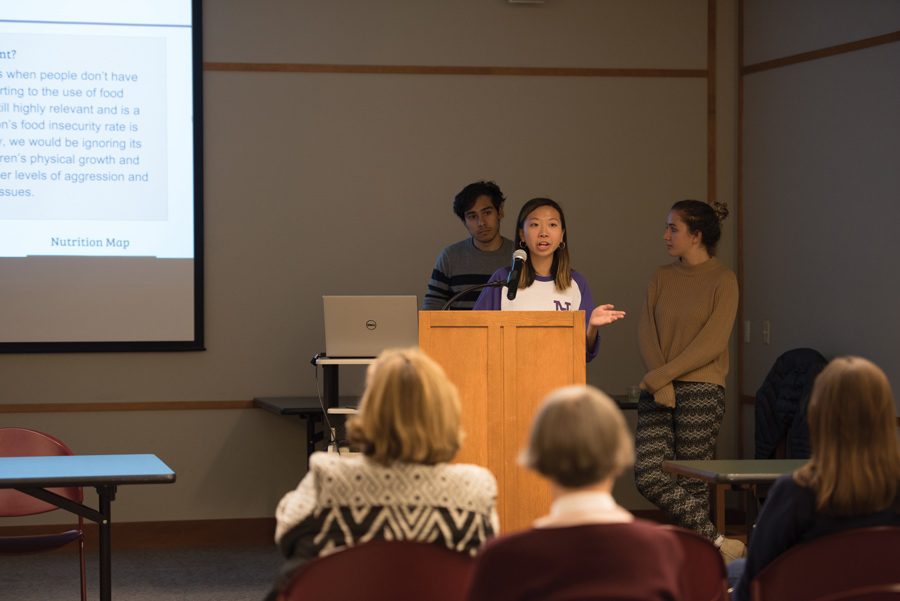Meals at Home, EPL launch food insecurity discussion with SESP research
Allie Goulding/Daily Senior Staffer
Northwestern SESP student Joanne Huang presents Evanston food insecurity findings at Evanston Public Library on Wednesday. The meeting was nonprofit Meals at Home’s first time partnering with EPL.
October 26, 2017
Northwestern students presented findings showing Evanston’s food insecurity rate ranged between 12.1 percent and 20 percent at a Wednesday event hosted by local nonprofit Meals at Home.
Around 30 people attended the discussion, which was held at Evanston Public Library, 1703 Orrington Ave. The event was the first installment of Meals at Home’s and the library’s collaborative speaker series.
After reaching out to local restaurants, grocery stores and nonprofits — including Meals at Home — to determine the best practices for addressing food insecurity, four NU students from the School of Education and Social Policy created a report.
“Our report is a resource and a jumping point for the discussion to be continued,” SESP junior Joanne Huang, who helped author the study, told The Daily. “This was a good step.”
Huang defined food insecurity as a state in which people do not have enough nutritious food that is safe to eat without resorting to the use of food donations, scavenging or stealing.
The students’ report included maps comparing the cost of 144 Evanston food sources and their nutrition. The study found that only three of 16 grocery stores in the city have “low prices,” or offer a meal for one person between $0 and $10. Thirty-one percent of all food sources offer healthy options and provide nutritional information, and of those, 70 percent are classified as fast food or casual dining.
“This means low-income consumers have to travel farther in order to go to these low-price food sources,” SESP junior Isabel Hoffman said. “They may choose to go to convenience stores or fast food places to get their nutrition.”
The students provided six suggestions in the report for the city to address food insecurity, including making convenience stores healthier, publishing their report on the city’s website and creating more community collaboration with nonprofits such as Meals at Home.
“There are so many people working on this problem already,” Meals at Home executive director Debi Genthe said. “If we do it together, we could really make a difference.”
Following the students’ presentation, Genthe explained to audience members how Meals at Home is addressing hunger in the North Shore’s low-income communities. She said volunteers deliver two meals a day to individuals who are unable to care for their nutritional needs.
The majority of the organization’s clients are over the age of 65 and are considered low-income, Genthe said. She added that Meals at Home also accommodates clients with special diets, such as those with diabetes or those who need dialysis.
“‘Fresh’ has been Meals at Home’s forte, versus the frozen stack of weekly meals that (other) organizations may deliver,” Genthe said.
Because volunteer delivery drivers are encouraged to interact with individuals at each stop, daily deliveries are also important to a client’s health because they help fight loneliness, Genthe said. She emphasized the importance of being made to feel like “(your) thoughts are important.”
Genthe said Meals at Home plans to host three more events with EPL over the next year.
“We need the message to get out in the community and get as many people involved in this process as we can,” she said. “We’ll get the ball rolling.”
Email: [email protected]
Twitter: @nikkibaim22


